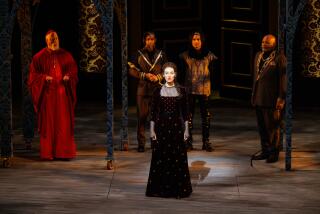The Siren’s Call: Henry’s game of thrones
If you’ve been eagerly awaiting the new season of “Game of Thrones,” which starts Sunday on HBO, Thomas Penn’s “Winter King: Henry VII and the Dawn of Tudor England” (Simon & Schuster: 448 pp., $30) offered an ideal way to bide your time (if you weren’t already busy rereading parts of George R.R. Martin’s saga).
Compared with the maneuvering of Starks, Lannisters and other houses in Martin’s epic, Penn’s book presents readers with the world of realpolitik as it was played out in the earliest years of the Tudor dynasty.
And yet here’s one other connection between Martin’s fantasy and Penn’s history: Martin has told interviewers that the English Wars of the Roses were one inspiration for his epic, and in Penn’s book we receive a fascinating portrayal of the victor of those wars, Henry of Richmond, the man who defeated Richard III in 1485 and was crowned Henry VII.
Most people easily recognize Henry VIII — who doesn’t think of that legendary leg of turkey in his fist? The same goes for Richard III, who, thanks to Shakespeare, is known today as the sinister crook-back figure “cheated of feature by dissembling nature.” But who was Henry VII?
That’s a harder question to answer. He’s a far more elusive figure.
In portraits, you almost never find him wearing a crown, only a plain black cap, which makes him seem, with his grim expression, more like a cleric or scholar than a king. His career is wedged between far more dashing, appealing monarchs. Some historians apply an innocuous expression to his reign as being merely “a time of transition.” This is why Penn’s book is so invaluable to us. Here is a skillful reclamation project, an absorbing picture of the oft-overlooked architect behind one of the greatest, most controversial dynasties in English history.
“Henry VII remains mysterious…’a dark prince,’” writes Penn, an editor at a London publisher. What Penn shows us is that what hides behind this cloak of mystery is a 24-year reign from 1485 to 1509 which “degenerated into oppression, extortion and a kind of terror” that would have impressed Joseph Stalin.
When illness threatened to kill him in 1507, two years before his actual death, Henry ordered that 7,209 Masses be sung for his soul. After finishing Penn’s book, you may decide 7,209 Masses weren’t enough.
Henry was a monarch who controlled by fear and force and used a vast network of spies and informers. “The hidden hand of the king” was everywhere, Penn explains, “testing, probing, controlling, and undermining the authority of his greatest subjects.” Henry courted a kind of instability because his reign depended on it.
Why? His claim to the throne was a thin one, coming through his mother’s family. His marriage to Edward IV’s daughter Elizabeth helped improve his legitimacy, but others claimed stronger (i.e. paternal, usually) ties to the throne.
So, even though Shakespeare has the character Henry declare peace after Bosworth, the real Henry faced a long string of pretenders (like Perkin Warbeck and Lambert Simnel) and genuine claimants (like the Duke of Buckingham and the Earl of Warwick) that kept the realm in permanent turmoil.
Penn shows us Henry’s furious maneuvering to ensure that the next generation of Tudors wouldn’t have his legitimacy problems. The deaths of his oldest son, Arthur, in 1502 and of Elizabeth in 1503 were a staggering blow in so many ways. When Henry VII pulls out of public view after these deaths, though, Penn’s characterization makes the reader suspect that Henry mourned the ruin of his royal plans as much as any personal losses that he felt.
His one shining consolation, especially in the case of losing his heir, was the presence of the spare, Henry, duke of York. We see how Henry VII threw everything into preparing his young son for kingship, including building a colorful cult of chivalry around him; we learn about Henry VII’s crafty investments (he made a bundle trading alum, a medicinal substance, on the international market) and the brutality of his henchmen as they interpreted — “distorted” or “abused” are probably more accurate words — any laws, suits or old debts in the king’s favor.
Penn’s story offers a rich pageant of players — agents and adversaries, courtiers and scholars, thugs and young aristocrats. But in the book’s later pages, the most captivating figure has to be young Prince Henry. As he nears manhood, his shadow looms large over his hollow-cheeked, fading father. His literary genius, love of the joust and gregariousness recall not his grasping, paranoid father, but his charismatic, lusty grandfather Edward IV (and, if you’re keeping a “Game of Thrones” score card, Edward’s probably the inspiration for jolly King Robert Baratheon).
There’s a touch of sunlight to the personalities of Prince Henry and Edward IV, even though both were as tyrannical as any ruler (and worse). Still, when we think of them, there’s a glow to their accomplishments that escapes the reign of Henry VII. His rule was a bleak time made even bleaker by his own ruthlessness. That’s why Penn’s book title is so well-chosen. No season suits Henry VII better than the winter.
“Game of Thrones”
George R.R. Martin’s prose is so visual, so rooted in appealing to our senses, that it doesn’t seem to leave much room for anyone interested in adapting it to another medium.
Martin’s saga of Westeros was even called “unadaptable” until David Benioff and D.B. Weiss came along. The producers of “Game of Thrones,” they managed with the rest of the HBO crew to find a way to adapt the story for television that’s at least satisfactory to some Martin fans. Times writer Geoff Boucher, on our sister blog, Hero Complex, talked to Benioff and Weiss last year about the challenges of adapting this mammoth epic (despite sounding redundant, in Martin’s case adding “mammoth” to “epic” seems justifiable) for HBO.
Now, Daniel Abraham and Tommy Patterson have taken up the challenge in another genre, “A Game of Thrones: The Graphic Novel — Volume One” (Bantam: $25), which appears later this month.
If you don’t know the story, their visualizing of the first part of the epic’s first book will be perfect. It provides a satisfying blend of characters and situations (and sex, so keep this one away from the kids) as tension builds between the frost-touched Starks and golden Lannisters.
At one point, as Eddard discusses grim matters with his wife in the godswood, his place of meditation, the haunting carved face of the heart tree looms behind them, dominating nearly every panel. It’s a wise move by Abraham and Patterson. It’s a clear, effective omen of bad things to come.
For anyone whose imagination has already been captured by the books, however, or if you’ve watched and enjoyed the HBO series, the graphic novel will pale beside them. There’s something missing; it isn’t that the creators of the graphic novel aren’t very good. Their skill is obvious on the page. They just make “Game of Thrones” seem like any other swords-and-more fantasy that is out there. And that couldn’t be further from the truth.
Martin, in a brief preface, offers that this graphic novel makes a decent introduction to his epic.
“Maybe you will even want to read the original novels when you’ve finished the comic. That would be cool,” he suggests. “Like those old Classics Illustrated com...er, graphic novels...this may be a gateway drug.”
So if you’re new to the story and eager to get up to speed before tuning in on Sunday, this is a good way to do it. But an important fyi: This volume covers only half the events of the first season. Volume 2 of the graphic novel won’t be available until later this year.
Owchar is deputy book editor. The Siren’s Call appears monthly at http://161.35.110.226/books
More to Read
The biggest entertainment stories
Get our big stories about Hollywood, film, television, music, arts, culture and more right in your inbox as soon as they publish.
You may occasionally receive promotional content from the Los Angeles Times.










